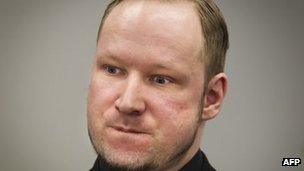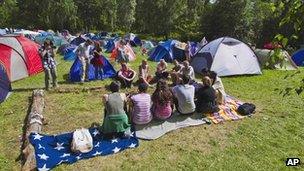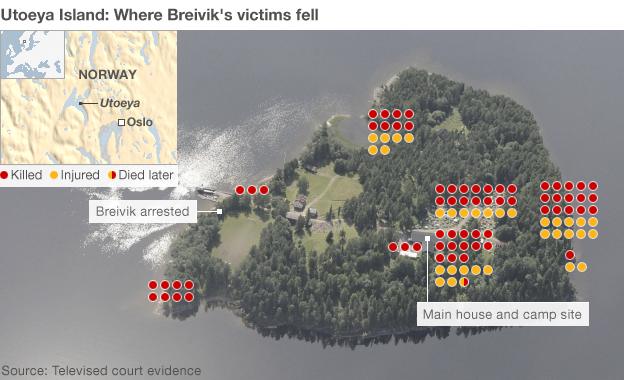Anders Breivik describes Norway island massacre
- Published

Breivik says he learned to shut off his emotions to kill his victims
Anders Behring Breivik has described how he shot people who were "begging for their lives" during his island rampage in which dozens died last July.
Testifying before an Oslo court, he described seeing people curled up and "completely paralysed" as he reloaded his weapon and shot them in the head.
Earlier the 33-year-old said he was normally a nice person but had shut off his emotions to carry out the attacks.
The main aim of the trial is to decide whether he is sane or insane.
On 22 July 2011, Breivik set off a car bomb near government buildings in Oslo, killing eight, and then massacred 69 participants in a Labour Party youth camp on the nearby island of Utoeya.
In Friday's testimony, he said he had arrived on the island dressed as a policeman, and told security officials at the camp he had been posted there following the bombings in the capital.
The BBC's Steven Rosenberg in the courtroom says Breivik then described in chilling detail how he killed people.
Before shooting his first victims, Breivik said he had "100 voices" in his head telling him not to do it.
But after that moment of hesitation, he said he pulled the trigger, shot two people in the head and moved on.
Displaying no emotion, Breivik went on to say he had entered a cafe where several people were hiding.
"Some of them are completely paralysed. They cannot run," he said. "Two people were curled up."
He said he reloaded after running out of ammunition. "People were begging for their lives. I just shot them in the head."
Others pretended to be dead, he added, but he knew they had not been wounded and shot them too.
Breivik continued his rampage around the island, luring youths from hiding places by telling them he was a police officer who was there to protect them.
When they came out, he said, "I shot towards many of them aiming at their heads."
The stunned silence in the courtroom was replaced with tears, our correspondent adds.
'Protection mechanism'
Breivik admits killing all 77 victims but denies criminal responsibility, saying he was defending Norway from multiculturalism.
He said he had envisaged the most important attack as being the Oslo bombing, but Utoeya "became the most important attack when the government building did not collapse" as planned.

Breivik's second target was a Labour Party summer youth camp on Utoeya
Depending on whether he is found sane or not, he faces either prison or committal to a psychiatric institution.
Breivik himself maintains he is sane but a practitioner of political extremism.
Earlier on Friday, he insisted he was "under normal circumstances a very nice person, very caring about those around me".
He said he "absolutely" understood why his testimony was horrifying to others.
But said he had embarked on a deliberate programme of "dehumanisation" in 2006 to prepare to carry out killings.
He added that empathy was not possible, as he would "break down mentally" if he tried to comprehend what he had done.
Asked if he could feel sadness, he said "yes", saying the funeral of a friend's brother had been his "saddest day".
In additional points, Breivik:
claimed he had not wished to kill "civilians" when he had targeted the government buildings in Oslo, only "government targets", but it was impossible to exclude "civilian" deaths entirely
said that from 2006 he had studied the weaknesses and strengths of organisations from the IRA to al-Qaeda, concluding that the most successful was al-Qaeda, because they "embrace martyrdom" - "and that is key to the successful resistance fight".
said it was impossible for "cultural conservatives" like him to get any of their ideas published in the media or in books, due to an alleged project to protect liberal beliefs
said he believed Japan and South Korea were ideal states, as they had "taken a stand against multiculturalism and Marxism in the 1970s"
In Thursday's testimony, Breivik said he hoped his car bomb in Oslo would kill the whole government, and had also hoped to kill all those on Utoeya - more than 500 in all.
Breivik's evidence is scheduled to last five days, concluding on Monday. The entire proceedings are expected to last 10 weeks.
